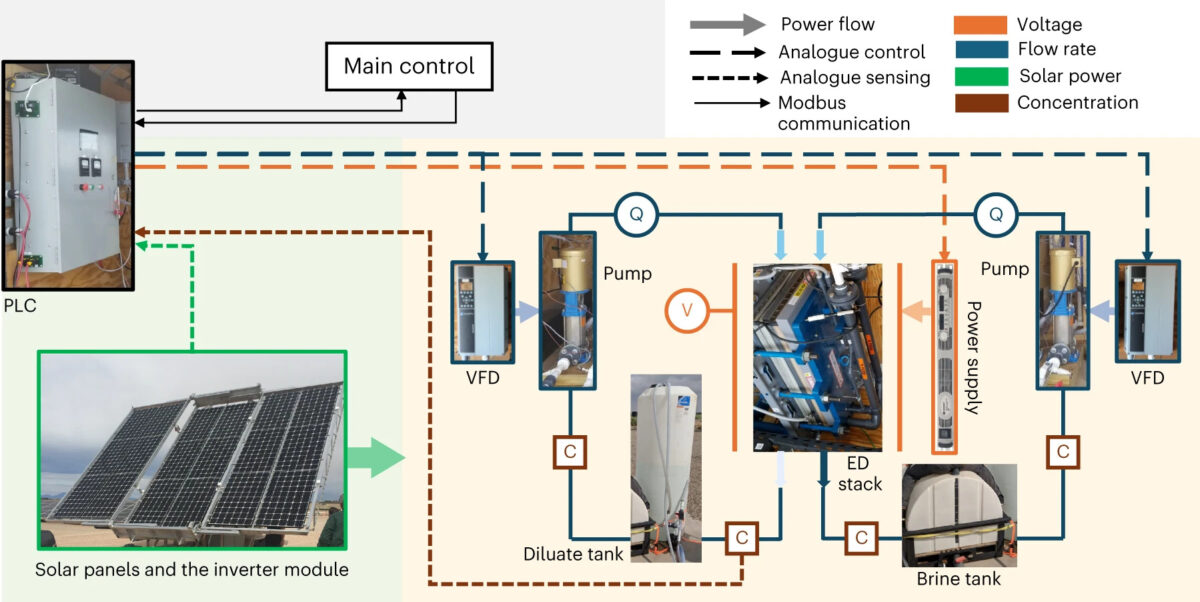A global group of scientists led by the Massachusetts Institute of Technology (MIT) developed a novel low-cost solar-powered brackish water desalination system that can reportedly reduce the levelized costs of water (LCOW) compared to conventional PV-driven desalination systems.
The proposed desalination system utilizes time-variant electrodialysis reversal (EDR) technology, which the researchers developed as a flexible variation of traditional EDR desalination. “Our research aims to address water scarcity in rural India where the majority of underground water is too saline to drink. The grid electricity access and stability are not good, suffering from frequent power cuts,” corresponding author, Wei He, told pv magazine.
“An EDR module is made up of a stack of ion exchange membranes and uses an electric field to move ions from the dilute flow channels to the brine flow channels between each membrane,” said the research group. “This electric field can be intermittently reversed to prevent the build-up of scale on the membrane.”
However, due to solar energy's intermittent nature, the classic EDR is not a perfect fit. It requires constant power for its operation, and therefore, PV-EDR plants need the support of batteries or oversized solar systems, particularly at the start and end of the day when solar power is low.
“To overcome these problems, we have developed a flexible batch EDR technology that incorporates a time-variant voltage and flow rate adjustment,” the academics explained. “A model-based control method enables the EDR system to align its power consumption with available solar power at each time step while optimizing water production under varying solar conditions.”
To control the operation, the team created a feed-forward, model-based main controller running in Python to compute the optimal pump flow rate and the EDR stack voltage based on real-time sensor readings. A prototype was built at a research facility, closely reflecting the typical design parameters and operational conditions for a community-scale PV-EDR system sized to produce 6 m3 freshwater per day. It was powered by a solar panel with an area of 37 m2 and a tilt of 30 degrees.
This pilot system was tested for single-day and six-day analysis and compared to the traditional constant-operation EDR system. Both systems were fed with water with an average starting salinity of 970 mg l−1. The system was set at a conservatively low water recovery ratio of 60%.

Image: Massachusetts Institute of Technology, Nature Water, CC BY 4.0 DEED
“The flexible system is able to directly use 77% of the available solar energy on average compared with only about 40% in the conventional system (a 91% increase),” the scientists emphasized. “This suggests that a conventional system would require much more solar panel area to operate directly (that is, without any energy storage), increasing capital costs.”
In addition, the analysis showed that the average minimum battery capacity required for the flexible system was 0.27 kWh, a 92% reduction compared to 3.3 kWh in the constant system. “Finally, the results show that the flexible system can reach its production volume up to 54% faster than the conventional system,” they added.
Following the experimental results, the researchers conducted a cost analysis case study for the usage of such a system in Chelluru, a rural village in India located near Hyderabad. Using computer simulation and optimization, it was compared to a conventional PV-EDR system, a state-of-the-art constant PV-EDR, and a commercial on-grid reverse osmosis (RO) desalination system. “RO uses pressure to force water through a polymer membrane, while its constitutive ions are blocked by the membrane,” the group said.
“The optimized levelized cost of water (LCOW) achieved by the proposed flexible PV-EDR system is US $1.66 m−3, which improves the cost by 22% compared with the current state-of-the-art PV-EDR system and by 46% compared with the conventional PV-EDR system,” the scientists found. “The LCOW for on-grid RO is US $1.71 m−3, 3% above the LCOW of flexible PV-EDR.”
Their findings were presented in “Flexible batch electrodialysis for low-cost solar-powered brackish water desalination,” published in Nature Water. The team included researchers from King's College London in the UK, and Helmholtz Institute Erlangen-Nürnberg for Renewable Energy (HI ERN) in Germany.
“For the next step, exploring the long-term performance and broadening the application scope of our PV-EDR technology beyond brackish water desalination presents a significant opportunity to address a wider array of global challenges related to water and liquid waste treatment,” concluded He.
This content is protected by copyright and may not be reused. If you want to cooperate with us and would like to reuse some of our content, please contact: editors@pv-magazine.com.



By submitting this form you agree to pv magazine using your data for the purposes of publishing your comment.
Your personal data will only be disclosed or otherwise transmitted to third parties for the purposes of spam filtering or if this is necessary for technical maintenance of the website. Any other transfer to third parties will not take place unless this is justified on the basis of applicable data protection regulations or if pv magazine is legally obliged to do so.
You may revoke this consent at any time with effect for the future, in which case your personal data will be deleted immediately. Otherwise, your data will be deleted if pv magazine has processed your request or the purpose of data storage is fulfilled.
Further information on data privacy can be found in our Data Protection Policy.